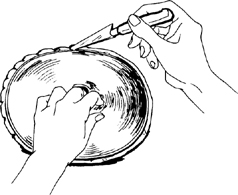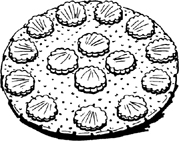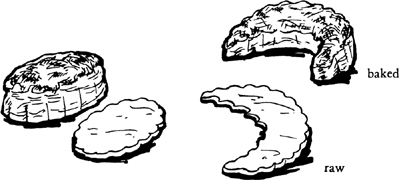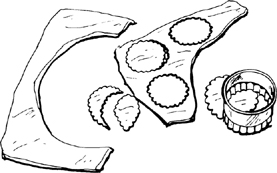Mastering the Art of French Cooking, Volume 2 (61 page)
Read Mastering the Art of French Cooking, Volume 2 Online
Authors: Julia Child

Half an hour before serving, bake in the middle level of a preheated 375-degree oven until nicely puffed and browned. Serve immediately.
MAKING A VOL-AU-VENT COVER
When you want a cover for the
vol-au-vent
, form it separately, and bake the 2 together on the same pastry sheet.
Use the circle of leftover dough you cut from the second disk of pastry that made the
vol-au-vent
ring. After it has rested in the refrigerator while you were making the
vol-au-vent
itself, roll it out into a disk about 9½ inches in diameter; loosen it from the rolling surface to let it shrink if it will. Roll it up on your pin and unroll upside down on a lightly buttered pastry sheet. Then trim it into a neat circle using an 8½-inch cutter or plate as a guide.
Place a slightly smaller cutter, cover, or other round object on top and draw the back of a knife from edge of pastry to edge of cutter at ¾-inch intervals all around to make a scalloped edging. |
|
| To discourage dough from rising more than a little in the oven, |
Using scraps of dough left over from the |
|
The design illustrated is a very simple one of circular cutouts, which puff up in an amusing manner; you may use ovals, leaves, strips of dough, or anything you wish, but remember that everything rises, and if you cut your shapes too thick and narrow, they may topple off in the oven.
Baking
Whether baked separately or along with the
vol-au-vent
, put the cover in a preheated 425-degree oven for about 20 minutes, until nicely browned, then turn thermostat down to 350. Pastry is done when it feels crisp and light, which should be 30 minutes or so in all. Let cool on a rack.
FLEURONS
[Puff-pastry Puffs, for Decorations and Garnitures]
When you are not making a cover for the
vol-au-vent
, you may wish some extra bits of puff pastry to decorate the edge of the platter around the shell. These are called
fleurons
, or flowered shapes, because they are small and decorative, usually fluted ovals or crescents. Classic French recipes often suggest
fleurons
as a garnish to some of the beautiful filet of sole or scallop dishes, where pastry elegantly takes
the place of a mundane starchy vegetable. You may make
fleurons
either out of the carefully preserved trimmings from your
vol-au-vent
or
bouchée
cuttings, or from the re-formed and reconstituted dough described after the next recipe.
Roll dough ¼ to ⅜ inch thick and make disks with a round, 3-inch, fluted cutter. With one stroke through the center, cut each disk into an oval and a crescent. |
|






